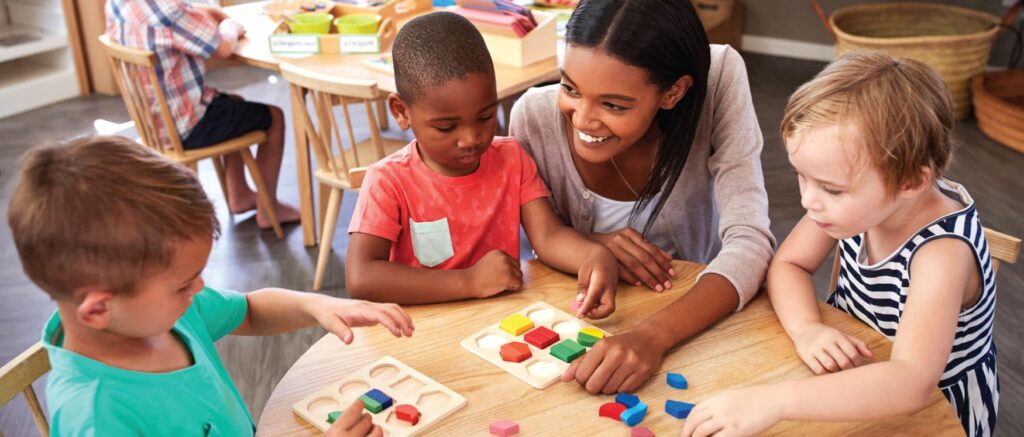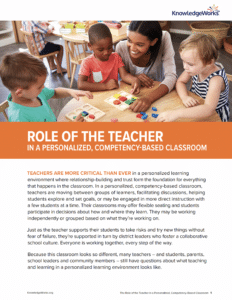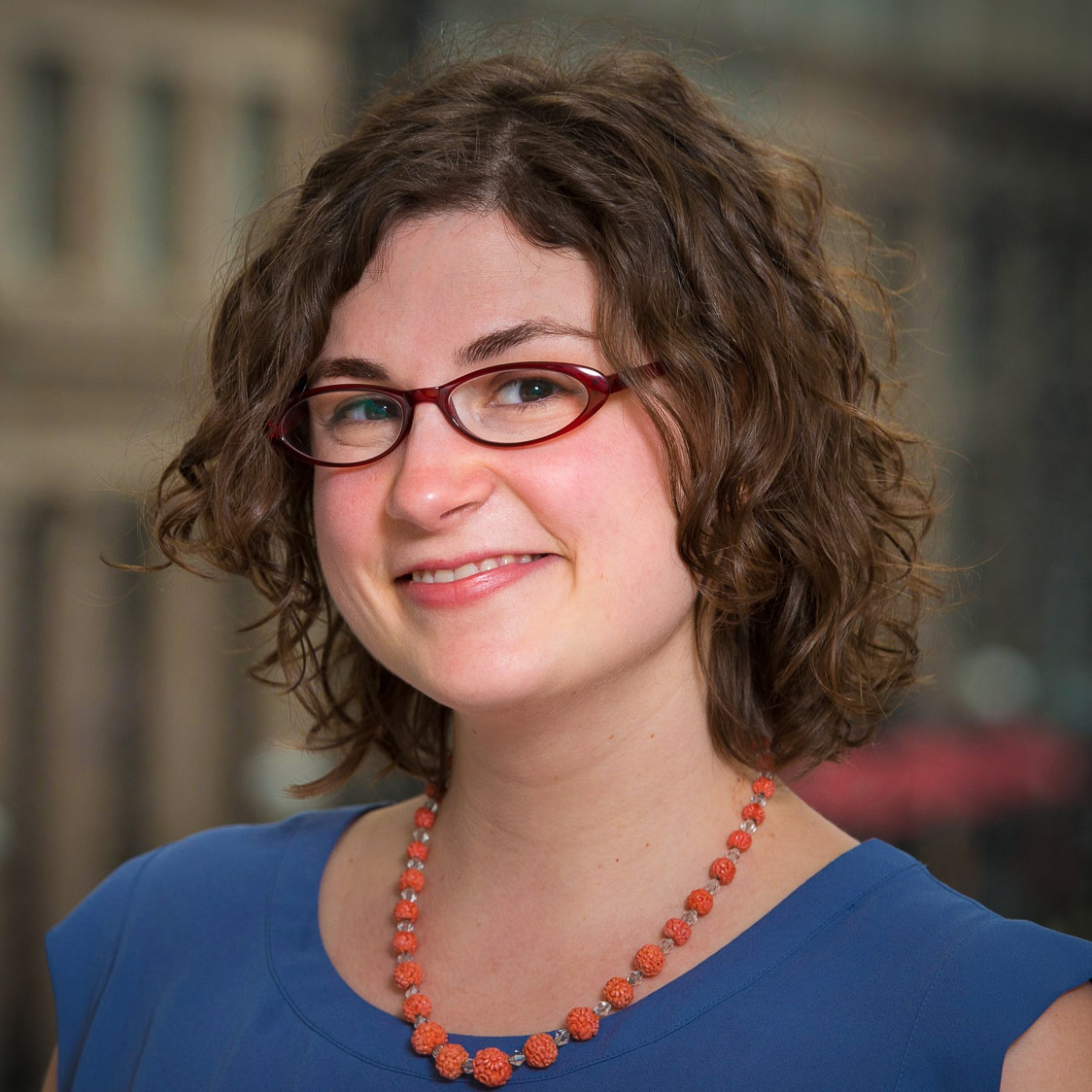
Teachers are more critical then ever in a personalized learning environment where relationship-building and trust form the foundation for everything that happens in the classroom.
In a personalized, competency-based classroom, teachers are moving between groups of learners, facilitating discussions, helping students explore and set goals, or may be engaged in more direct instruction with a few students at a time. Their classrooms may offer flexible seating and students participate in decisions about how and where they learn. They may be working independently or grouped based on what they’re working on.
Just as the teacher supports their students to take risks and try new things without fear of failure, they’re supported in turn by district leaders who foster a collaborative school culture. Everyone is working together, every step of the way.
Because this classroom looks so different, many teachers – and students, parents, school leaders and community members – still have questions about what teaching and learning in a personalized learning environment looks like.
What’s the difference between teacher-centered and student-centered classrooms?
In a traditional, teacher-centered classroom, teachers ask questions and students answer. Teachers choose what students will be working on and when and deliver direct instruction, often to the whole class at once. Conversely, in a student-centered, personalized classroom the teacher works with students and has the resources and supports that they need to take risks and follow their students’ lead.
In a literacy lesson, for example, a teacher may work with a small group of students whose assessments show they need support in the same skill area, while other students work through learning stations with tasks designed to strengthen their learning. Students benefit from individually-paced, targeted learning tasks that start from where the student is, formatively assess existing skills and knowledge and address the student’s needs and interests.
“If you ask [my students] what they are working on in literacy they can say, ‘I’m doing syllables right now,’ or ‘I don’t need to do my letters anymore because I know them already,’” said Marie Roy, a kindergarten teacher at Henry L. Cottrell Elementary School in RSU 2 in Monmouth, Maine. “They know exactly what to expect, and where they need to be, and where they need to get their materials from so they are able to move through their targets at a pretty independent pace.”
What does classroom management look like in a personalized, competency-based environment?
The idea of students choosing how they learn, how they show you what they’ve learned, working independently or grouping and regrouping throughout the day, might sound messy to teachers. But the student who feels trusted and has ownership over their learning is a more focused and productive student. Learners also have ample opportunities to practice those critical social and emotional skills that will serve them well in the future when they can recognize their own role in enriching the learning environment. Teachers are still responsible for the class, but when students build a community together, deciding on classroom rules and similar procedures, they hold themselves and each other accountable.
In an elementary classroom, students may decide as a class on an appropriate way to handle classroom materials such as markers or scissors, whereas older learners may decide on how long they have to revise an assignment. These rules still exist – but they are decided upon and enforced by the community, building student agency and ownership.
“I really wanted to be in charge of my classroom,” said Hillary Weiser, a kindergarten teacher at Navin Elementary School in the Marysville Exempted Village School District in Marysville, Ohio. “But I’ve learned to let the kids take charge of their own learning. I have no discipline issues this year, and I don’t think it’s anything I’ve done. This classroom is theirs. They take ownership of what happens here.”
Does personalized learning mean teachers create personalized lesson plans for every student?
Personalizing learning doesn’t mean writing 30 different lesson plans for 30 students, but rather cultivating in students an understanding of themselves as learners and turning over some of the work to the students themselves. Transparency about learning expectations is also key in a personalized, competency-based classroom – if students are aware of their learning targets and what they need to do to demonstrate mastery, learning isn’t a mystery.
In a science class, for example, a teacher may share out at the beginning of the unit the learning targets that each student will need to meet, and work with each student to design the assessment that allows them to demonstrate mastery – whether that’s writing a paper, delivering a presentation, taking a test or something else.
How do teachers support each student’s individual needs?
To truly personalize learning, teachers must have the support and freedom they need to understand and support each child holistically. Whether it’s a unique family situation, a different culture than their own, poverty or trauma, teachers must have the flexibility to meet their students’ needs in creative and appropriate ways.
Many teachers use data notebooks with students as a way of involving the kids in goal setting and progress monitoring. The notebooks can also include learner profiles, where students set goals and reflect on the ways in which they learn best. “Do I learn my math facts when I am using flashcards or working with a partner?” “What do I need to do my best on this task?” Making the most of the data notebooks can also support a classroom culture that encourages growth mindset: approaching new tasks and skills as an opportunity to learn and grow rather than assuming skills are predetermined.
When personalizing learning, there is a necessary cultural and systemic shift throughout a learning community that brings inequitable practices to light and has the potential to empower teachers to take action and alleviate those inequities. This may require tough, but necessary, conversations about how to serve each child well.
“We offered afterschool sessions for those learners who needed additional help, and were naturally frustrated when the students knew we needed the support didn’t show up,” said Abbie Forbus, director of teaching and learning with KnowledgeWorks and formerly director of culture at Lindsay Unified School District in Lindsay, California. “But when we asked students, we were surprised to learn that because so many of their parents were migrant workers who had to go and work in the fields after school, these students needed to get home to care for siblings. Afterschool sessions were never going to work for them, so we needed to find a way to work extra time into the school day. If we’d stopped and asked our learners first what they needed, we’d have been able to work together to find the best solution from the start.”
How will assessments work? How will teachers determine if a student has demonstrated mastery?
While end-of-year summative assessments are still a reality for schools, teachers in a personalized learning environment must be comfortable with frequent, embedded student assessments that are closely aligned to instruction so that results can quickly translate into supports for students. These embedded, formative assessments also naturalize the process of assessing progress. Rather than seeming punitive, assessments become a regular touchpoint for both teachers and students to get a pulse on what they know and what they don’t know yet. After an assessment, students can also chart their own growth and set their own learning goal, determining what they will do to reach their goal and what they need their teacher to do. They own their learning.
“I get to focus on what kids really know, and what they don’t know, and what I can do to get them there,” said Brooke Young, a math teacher at Marysville Early College High School in the Marysville Exempted School District in Marysville, Ohio. She described a recent project her students undertook to demonstrate their understanding of quadratic functions, where rather than just take a test, her students chose to pursue a video project. Young recognized her students’ passion for video production and IT, and though she didn’t have the expertise herself, she provided the structure necessary for her students to plug their learning into something that was meaningful for them and still gave the opportunity to show what they’d learned. “I told them, ‘I’m going to take a risk with you.’ We dove in together,” Young said.
How does personalized learning change the nature of professional development?
Rethinking annual professional development to explicitly support a teacher’s confidence and the development of strategies for personalized learning is critical. Most educators weren’t trained in personalized learning strategies but are excited at the prospect of having more freedom to meet their students where they are. Growth mindset and comfort with failure as a part of the learning process is something that teachers must cultivate in their interactions with students, and it’s made possible by feeling that same support from district leaders and administrators. Teachers need to feel that they are trusted and that if they try something new and it doesn’t work out, they can revisit and adjust.






